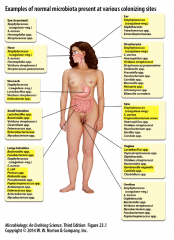![]()
![]()
![]()
Use LEFT and RIGHT arrow keys to navigate between flashcards;
Use UP and DOWN arrow keys to flip the card;
H to show hint;
A reads text to speech;
23 Cards in this Set
- Front
- Back
|
Hosts
|
- our body contains 10 times as many bacterial cells as human cells |
|
|
Microbiome
|
- human microbiome includes microbes in mouth, skin, respiratory tract, digestive and reproductive systems |
|
|
Examples of Microbiota Present on Body
|

- |
|
|
Skin
|
- has acidic pH (pH 4-6) due to secretions of acids by oil and sweat glands. secretions are high in salt, low in water, and contain lysozyme |
|
|
Lysozyme in Skin Secretions
|
- degrades peptidoglycan, inhibiting bacterial growth |
|
|
Skin Microflora |
- mostly Gram-positive, since they are resistant to salt and dryness |
|
|
Common Skin Microbes
|
- Staphylococcus epidermidis - Various Bacillus species - yeasts like Candida |
|
|
Acne
|
- same geneus as bacterium that makes swiss cheese - treatments include oral tetracycline or topical clindamycin to kill bacteria |
|
|
Skin Microflora Protection from Pathogens
|
- also increases acidity of the skin via bacterial fermentation of lipids (forming acetate), making it more inhospitable |
|
|
Acquisition of Microbiome
|
|
|
|
Microbes on Teeth
|
- Microbes adhere to surfaces by forming biofilms (Streptococcus mutans and salivarius) - Acidic fermentation products demineralize teeth and cause tooth decay |
|
|
Microbial Habitats of the Throat
|
- nasopharynx and oropharynx - contains Staphylococcus aureus and epidermis |
|
|
Microbial Habitats of the Lungs and Trachea
|
|
|
|
Cilia in Nose
|
- trap organisms entering the nasopharynx and propel them down to the acidic stomach |
|
|
Mucociliary Elevator |
- microbes that slip into the trachea are trapped by mucus and swept upward by cilia
|
|
|
Stomach Acidity
|
- Stomach lining is pH 5-6 - H. pylori can resist pH 1 environment using urease to neutralize acid, but cannot grow in pH 1 - H. pylori growns instead st stomach lining where pH is more basic - half of world population has it |
|
|
Intestine Structure
|
- Pancreatic secretions (pH 10) enter the intestine and raise intestinal pH to 8, which relieves acid stress on microbes |
|
|
Microbes in Intestine
|
- Only a few resident microbes live in the small intestine; most are Gram-positive that posses salt hydrolase which allow them to grow in the presence of bile salts - colon is slightly acidic and has lower bile salt concentration, and supports a more vibrant ecosystem - intestinal lumen is anaerobic due to O2 consumption by facultive microbes - intestinal bacteria encompasses 400-500 different species as well as methanogenic archea - have special talents that allow them to build and colonize that intestinal wall - many different food sources are available to support diverse microbes |
|
|
Effects of Different Intestinal Microbiota on Human Health
|
- connection between obesity and presence of methanogens in intestines - Bacteroides thetaiotaomicron breaks down complex carbohydrates so we can absorb them - breast milk can only be broken down by specific bacteria - Encourage immune system development - Compete with pathogenic species for nutrients |
|
|
Probiotics
|
- thought to restore balance to microbial community - outcompete pathogenic bacteria - production of anti-microbials - immunomodulation |
|
|
Fecal Microbiota Transplant
|
- intestinal microbiome of a healthy person is transferred to a relative with severe intestinal disease - can relieve symptoms of IBD or colitis - also effective for patients suffering from clostridium difficile infection |
|
|
Urinary Tract
|
- Consists of Kidneys, Ureters, Urinary Bladder, Distal Urethra - Most of urinary tract is free of microbes - urethra normally contains Staphylococcus epidermis and Enterococcus species which can cause UTI if they get to bladder. |
|
|
Vaginal Microflora
|
- nutrients and pH change with menstrual cycle - acidic nature of vaginal secretion (pH 4.5) discourages growth of many microbes - acid tolerant Lactobacillus is the most populous species |

